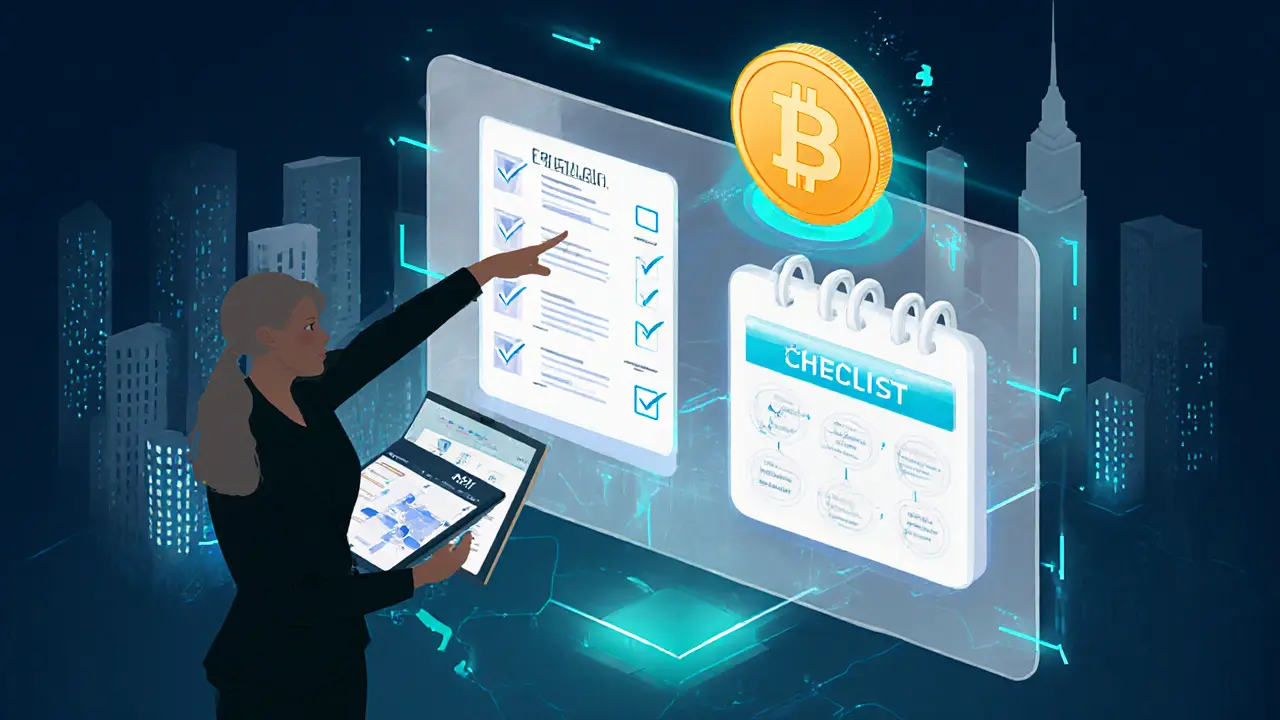Crypto License Cost & Time Calculator
Estimated Requirements
Total Estimated Costs
Estimated Timeline
License Details
FinCEN MSB
$0 registration fee
2-4 weeks approval
New York BitLicense
$500K capital
9-12 months approval
California MTL
$250K capital
4-6 months approval
Wyoming SPDI
Varies by volume
~90 days approval
Quick Takeaways
- All U.S. crypto firms must register as a Money Services Business (MSB) with FinCEN.
- State licenses vary: New York’s BitLicense is the toughest, while Wyoming offers a flexible SPDI charter.
- Typical capital requirements range from $250,000 (CA) to $500,000 (NY).
- Full compliance costs often exceed $500,000 before you can launch.
- Following a 7‑step checklist cuts approval time by up to 40%.
Starting a crypto venture in the United States feels like navigating a maze of federal rules and 47 state frameworks. This guide cuts through the clutter, walks you through every license you’ll need, and shows how to avoid the most common roadblocks.
What "Cryptocurrency Business Licensing means the combined set of federal and state authorizations required to legally offer crypto‑related services in the U.S.?
In plain English, if you want to let users trade, hold, or move digital assets, you’ll need at least two things: a federal MSB registration and, depending on where your customers live, one or more state‑level permits. The system is deliberately layered to keep money‑laundering, fraud, and consumer‑protection risks in check while still allowing innovation.
Federal Layer: Registering as an MSB with FinCEN the Treasury’s Financial Crimes Enforcement Network, which enforces the Bank Secrecy Act.
The 2013 FinCEN guidance classified crypto exchangers and custodians as MSBs. That means you must:
- File an MSB registration using FinCEN Form 107.
- Implement a robust Anti‑Money Laundering (AML) Program covering customer due‑diligence, transaction monitoring, and SAR filing..
- Keep transaction records for at least five years and report any cash‑equivalent transfers over $10,000.
- Designate a compliance officer and file periodic updates whenever your business model changes.
Failing to register can trigger civil penalties of up to $250,000 per violation and, in extreme cases, criminal charges.

State‑Level Licenses: The Patchwork You Must Piece Together
While the federal MSB registration is a baseline, state regulators focus on money‑transmission activities-essentially any crypto‑to‑fiat conversion, custody of user funds, or payment processing. Below are the most influential state regimes.
New York’s BitLicense (NYDFS the New York State Department of Financial Services, the agency that issues the BitLicense.)
BitLicense applies to any entity that receives, transmits, stores, or exchanges virtual currency for New York residents. Requirements include:
- Minimum net capital of $500,000.
- Comprehensive cybersecurity framework meeting NYDFS Part 500 standards.
- Bi‑annual independent audits of AML and cybersecurity controls.
- Application fee of $5,000 plus a $1,000 annual renewal.
Approval timelines average 9‑12 months, and the process is often cited as the benchmark for “best‑in‑class” compliance.
California Money‑Transmitter License (MTL)
California treats crypto‑to‑fiat services as traditional money transmission. Key points:
- Minimum net worth: $250,000.
- Bond requirement of $250,000 for the first $1billion in transaction volume.
- Application fee of $500; renewal $300.
- Requires a dedicated compliance officer and a 30‑day “cool‑off” period for suspicious activity review.
Wyoming’s SPDI Charter (Special Purpose Depository Institution a state‑chartered banking entity that can hold crypto assets and offer limited banking services.)
Wyoming created a crypto‑friendly regulatory sandbox:
- No fixed net‑worth floor; capital based on business scale.
- Allows direct custody of digital assets and issuance of stablecoins.
- Single application portal covering both banking and money‑transmission requirements.
- Typical approval time: 90 days.
Illinois and Other Exemptions
Illinois exempts pure‑crypto exchanges that never touch fiat from licensing, but if you ever plan to bridge to dollars you’ll still need an MSB and a state MTL.
Step‑by‑Step Application Process (7Steps)
- Finalize Your Business Model - Determine whether you’re an exchange, custodian, payment gateway, or a hybrid.
- Register with FinCEN - Complete Form 107, upload your AML policy, and obtain your MSB ID.
- Secure a Banking Partner - Approach crypto‑friendly banks; be prepared to provide your AML program and risk assessment.
- Gather Documentation - Business plan, ownership chart, KYC/AML procedures, cybersecurity controls, financial statements, and background checks for principals.
- Apply for State Licenses - Use each state’s portal (NYDFS, CA Department of Financial Protection, Wyoming Division of Banking, etc.). Pay the non‑refundable fees.
- Undergo Review & Audits - Expect requests for additional information, on‑site inspections (NY), or third‑party audit reports.
- Maintain Ongoing Compliance - File SARs, conduct annual audits, update AML policies, and monitor regulatory changes.
Following this checklist can trim the average 8‑month approval window down to roughly 5months.
Cost & Capital Snapshot (Table)
| License | Minimum Net Worth / Capital | Application Fee | Typical Approval Time |
|---|---|---|---|
| FinCEN MSB Registration | $0 (but must fund AML program) | $0 (registration is free) | 2-4 weeks |
| New York BitLicense | $500,000 | $5,000 + $1,000 annual | 9-12 months |
| California MTL | $250,000 | $500 (application) / $300 (renewal) | 4-6 months |
| Wyoming SPDI Charter | Based on projected volume (average $150,000) | $1,200 | ~90 days |
| Illinois Exemption (crypto‑only) | N/A | N/A | Immediate (no license) |

Common Pitfalls & Pro Tips
Pitfall #1: Ignoring the banking hurdle. Over 70% of startups report being denied a correspondent bank because the bank’s AML team can’t verify the crypto‑risk model. Pro tip: Partner early with a fintech‑friendly bank and provide a detailed risk‑based AML framework.
Pitfall #2: Under‑estimating capital reserves. Many firms budget only the application fees. Pro tip: Model worst‑case transaction spikes and keep a 12‑month cash buffer meeting the highest state net‑worth requirement (currently $500k).
Pitfall #3: Treating state licenses as optional. If you serve New York residents, the BitLicense applies regardless of where you’re incorporated. Pro tip: Use a geolocation filter or a separate legal entity for NY customers to avoid retroactive exposure.
Pitfall #4: Weak cybersecurity documentation. NYDFS Part 500 audits will reject generic “firewall” statements. Pro tip: Adopt a NIST‑based security framework, run quarterly penetration tests, and keep detailed evidence ready.
Licensing Checklist for a Smooth Launch
- ✅ Confirm business model aligns with MSB definition.
- ✅ Register with FinCEN and obtain MSB ID.
- ✅ Draft AML/CFT program that covers KYC, transaction monitoring, SAR filing.
- ✅ Choose a banking partner experienced with crypto MSBs.
- ✅ Prepare state‑specific documentation (ownership chart, net‑worth proof, cybersecurity plan).
- ✅ Submit applications in parallel where possible to cut overall timeline.
- ✅ Set up automated compliance monitoring (e.g., Chainalysis, CipherTrace).
- ✅ Schedule annual independent audits and maintain a compliance calendar.
Frequently Asked Questions
Do I need a BitLicense if I only serve customers outside New York?
Yes, if any of your users are physically located in New York or use a NY‑based IP address, the BitLicense applies. Many firms create a separate NY‑focused entity to isolate that exposure.
Can a DeFi protocol be considered an MSB?
The 2024 FinCEN update clarified that DeFi platforms with a central governing contract or administrator must register as an MSB. Fully decentralized protocols without a controlling entity may be exempt, but regulators are still watching closely.
How long does a typical state license take to approve?
Approval varies: New York averages 10months, California 5months, Wyoming about 90days, and smaller states often under 4months. Parallel filing can reduce total calendar time.
What are the biggest ongoing compliance costs?
Annual audit fees ($25‑$75k), AML software subscriptions ($15‑$30k), and the cost of maintaining a dedicated compliance officer (salary $120k‑$180k) dominate the recurring budget.
Is it cheaper to launch in Wyoming than New York?
Generally yes. Wyoming’s SPDI charter has lower capital thresholds and a faster review, but you’ll still need a BitLicense if you want any New York customers, which adds the higher cost and compliance burden.
Next Steps for Your Crypto Venture
1. Map where your target users live - that tells you which state licenses you must chase.
2. Draft an AML program using a NIST‑aligned template; get a compliance consultant to review it before filing.
3. Open a dialogue with a crypto‑friendly bank - do this early, because the bank will ask for your MSB registration and AML policy.
4. Submit the FinCEN MSB form while you prepare state applications in parallel.
5. Set up a compliance dashboard to track filing deadlines, audit dates, and capital‑reserve ratios.
Once you’ve ticked those boxes, you’ll be positioned to launch with confidence, avoid costly delays, and focus on building the product instead of fighting regulators.


Author
Ronan Caverly
I'm a blockchain analyst and market strategist bridging crypto and equities. I research protocols, decode tokenomics, and track exchange flows to spot risk and opportunity. I invest privately and advise fintech teams on go-to-market and compliance-aware growth. I also publish weekly insights to help retail and funds navigate digital asset cycles.